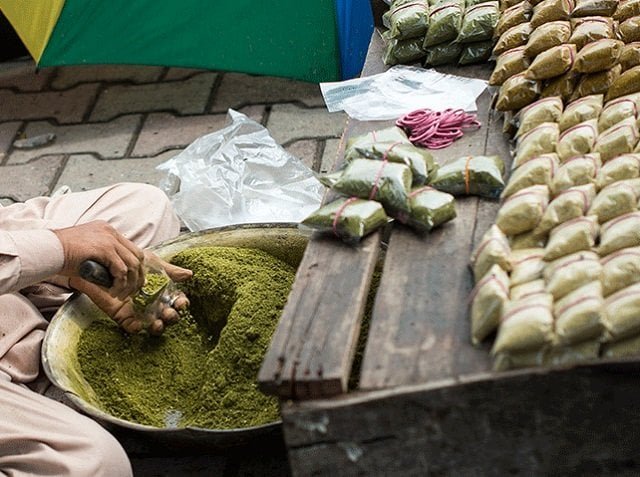Smokeless tobacco consumption, particularly Naswar, has gained significant prevalence in Pakistan, posing grave threats to public health. There is an urgent need to investigate the comprehensive regulation of Naswar, delving into the critical aspects surrounding Naswar and other forms of smokeless tobacco products. Smokeless tobacco consumption, specifically the use of Naswar, has been a long-standing and pressing public health concern in Pakistan.
The unregulated sale of Naswar contributes significantly to its widespread availability. A licensing system for vendors is imperative to monitor and control distribution. Licensing ensures that sellers adhere to age restrictions, quality standards, and packaging regulations. By implementing a vendors’ licensing mechanism, the government can exercise better control over the production, sale, and distribution of Naswar, mitigating the risks associated with unregulated consumption. Civil society organizations such as Blue Veins and Sustainable Development Policy Institute (SDPI) have been advocating the initiation of a licensing system in KP and subsequently in other provinces.
Numerous studies have linked Naswar consumption to an increased risk of oral cancers. The harmful substances present in Naswar, such as tobacco-specific nitrosamines (TSNAs), use of ash, guar-gum, heavy metals, and preservatives have carcinogenic properties. Rigorous regulation is essential to limit exposure to these harmful substances, reducing the incidence of mouth cancer among Naswar users straining an already over-stretched health system.
While Naswar is the predominant form of smokeless tobacco in Pakistan, other variants, including gutka, paan, nicotine pouches, khaini, etc. contribute to the overall burden of smokeless tobacco-related health issues. Regulatory measures must extend beyond Naswar to encompass all forms of smokeless tobacco, ensuring a comprehensive approach to public health. Sindh province in particular and other provinces in general are under the heavy use of all these unregulated tobacco products.
Smokeless tobacco consumption, particularly the use of Naswar, presents a significant public health challenge in Pakistan. Amidst various regulatory measures, the incorporation of pictorial and textual health warnings on smokeless tobacco products emerges as a global best practice. While only one Naswar manufacturer in Pakistan currently adheres to this practice, the Punjab Food Authority’s mandate to place warnings on smokeless tobacco products signals a crucial step toward improving public health outcomes.
Countries worldwide have recognized the efficacy of health warnings in combating the health hazards associated with tobacco use. Pictorial warnings, accompanied by compelling textual messages, have proven to be powerful tools in conveying the risks and consequences of tobacco consumption. These warnings serve as a direct communication channel, transcending linguistic and educational barriers to reach a diverse audience.
Leading nations, including Canada, Australia, and several European countries, have successfully implemented regulations mandating prominent and explicit health warnings on smokeless tobacco products. The integration of graphic images depicting the health consequences of tobacco use, alongside concise textual warnings, has been instrumental in educating consumers and discouraging tobacco consumption.
In Pakistan, the use of pictorial and textual health warnings on Naswar packages is not yet a widespread practice. Despite the presence of extensive scientific evidence linking Naswar consumption to severe health risks, the majority of manufacturers have not embraced this crucial regulatory aspect.
Recognizing the urgency of addressing the public health implications of smokeless tobacco, the Punjab Food Authority has taken a commendable step by obligating the placement of pictorial and textual health warnings on smokeless tobacco products, including Naswar. This regulatory intervention is aligned with global best practices and reflects a commitment to protecting the well-being of consumers.
The Punjab Food Authority’s mandate not only aligns with international standards but also sets a precedent for other provinces in Pakistan to follow suit. By making health warnings mandatory, regulatory bodies can significantly contribute to raising awareness about the dangers of Naswar consumption and encourage responsible manufacturing practices.
Studies conducted globally attest to the effectiveness of health warnings in influencing consumer behavior. Pictorial warnings, in particular, have been shown to evoke emotional responses, fostering a deeper understanding of the potential health consequences. By incorporating such warnings on Naswar products, manufacturers and regulatory bodies can empower consumers to make informed choices, thereby contributing to a reduction in smokeless tobacco consumption.
The rise of unregulated tobacco pouches, mimicking popular international brands like snus, adds a layer of complexity to the regulatory landscape. These products often escape scrutiny, circumventing established regulations and posing additional health risks to users. Stringent measures are needed to curb the proliferation of such imitative products and protect consumers from potential harm. The influx of nicotine pouches poses a new and formidable threat, especially among the younger population. These pouches, containing high concentrations of nicotine, contribute to the alarming rise in nicotine addiction among children. Regulatory frameworks must adapt to address emerging trends and prevent the unrestricted growth of this harmful phenomenon. It is also noteworthy that countries such as Australia, Brunei Darussalam, the Czech Republic, and Malaysia have classified nicotine as a “poison” and a “hazardous substance”. A doctor’s prescription is needed to purchase these products. Pakistan needs to conduct a dispassionate introspection and take control of the health of our future generation.
Children are particularly vulnerable to the addictive nature of nicotine and the allure of smokeless tobacco. The accessibility and appeal of Naswar, coupled with the emergence of nicotine pouches, demand urgent regulatory intervention. Implementing and enforcing strict age restrictions, comprehensive public awareness campaigns, and educational programs are essential components of a multifaceted approach to combat children’s addiction.
Understanding the cultural dimensions of Naswar use is crucial for crafting effective regulations that are sensitive to local practices. In certain regions of Pakistan, Naswar holds cultural significance, making outright bans challenging. Regulatory strategies must strike a balance between preserving cultural practices and safeguarding public health, perhaps by advocating the health benefits of quitting Naswar use altogether.
Regulation of smokeless tobacco, particularly Naswar, in Pakistan, is an urgent imperative for safeguarding public health. Through the implementation of vendors’ licensing, addressing the association with mouth cancer, regulating other forms of smokeless tobacco, learning from global best practices, curbing the imitation of snus by unregulated tobacco pouches, combating the menace of unregulated nicotine pouches, addressing children’s addiction, and understanding the cultural context of Naswar use, a comprehensive regulatory framework can be established. Policymakers need to act swiftly and decisively to protect the well-being of the population and mitigate the growing health risks associated with smokeless tobacco consumption in Pakistan.
Authors: Tobacco Control Advocates Sana Ahmed works at the Blue Veins in Peshawar and Dr. Waseem Janjua works at the Sustainable Development Policy Institute (SDPI), Islamabad.

